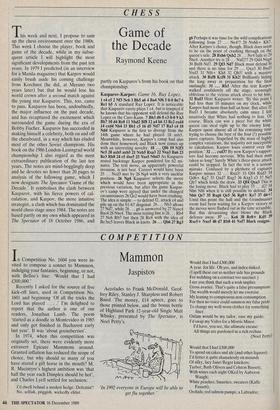CHESS
Game of the Decade
Raymond Keene
This week and next, I propose to sum up the chess environment over the 1980s. This week I choose the player, book and game of the decade, while in my subse- quent article I will highlight the most significant developments from the past ten years. In 1979 I predicted (in an interview for a Manila magazine) that Karpov would easily brush aside his coming challenge from Korchnoi (he did, at Merano two years later) but that he would lose his world crown after a second match against the young star Kasparov. This, too, came to pass. Kasparov has been, undoubtedly, the major influence on the past decade, and has recaptured the excitement which surrounded the game during the era of Bobby Fischer. Kasparov has succeeded in making himself a celebrity, both on and off the chessboard, in a way which has eluded most of the other Soviet champions. His book on the 1986 London-Leningrad world championship I also regard as the most extraordinary publication of the last ten years. The notes are mind-bogglingly deep and he devotes no fewer than 20 pages to analysis of the following game, which I now designate The Spectator 'Game of the Decade.' It symbolises the clash between Kasparov, with his fierce powers of cal- culation, and Karpov, the more intuitive strategist, a clash which has dominated the world chess stage since 1984. The notes are based partly on my own which appeared in The Spectator of 18 October 1986, and
partly on Kasparov's from his book on that championship.
Kasparov-Karpov: Game 16, Ruy Lopez. 1 e4 e5 2 NI3 Nc6 3 13b5 a6 4 Ba4 Nf6 5 0-0 Bel 6 Rel b5 A standard Ruy Lopez. It is noticeable that Kasparov rarely plays 1 e4, but is tempted if he knows that his opponent will defend the Ruy Lopez or the Caro-Kann, 7 Bb3 d6 8 c3 0-0 9 h3 Bb7 10 d4 Re8 11 Nhd2 Bf8 12 a4 h6 13 Bc2 exd4 14 cxd4 Nb4 15 Bbl c5 16 d5 Nd7 17 Ra3 c4 18 Nd4 Kasparov is the first to diverge from the 14th game where he had played 18 axb5. Meanwhile, however, Karpov's camp had also done their homework and Black now comes up
with an interesting novelty. 18 Qf6 19 N2f3 Nc5 20 axb5 axb5 21 Nxb5 Rxa3 22 Nxa3 Ba6 23 Re3 Rb8 24 e5 dxe5 25 Nxe5 Nbd3 As Kasparov rested backstage Karpov pondered for 62 mi- nutes. The text move, an apparently powerful invasion, is not best. Correct would have been 25 Ncd3 met by 26 Ng4 with a very unclear position. 26 Ng4 Kasparov selects the move which would have been appropriate in the previous variation, but after the game Kaspar- ov's camp were agreed that under the changed circumstances 26 Qc2 would have been crushing. The idea is simple — to defend 12, attack c4 and pile up on the bl-h7 diagonal. 26 ... Nb3 allows 27 Nd7, while 26 ... g6 is answered by 27 Naxc4 Bxc4 28 Nxc4. The most testing line is 26 ... Rb4 27 Nc6 Rb7 but then 28 Re8 with the idea of Be3xc5 leaves Black in knots. 26 ... Qb6 27 Rg3
g6 Perhaps it was time for the wild complications following from 27 ... Ne4!? 28 Nxh6+ Kh7. After Karpov's choice, though, Black does seem to be on the point of crashing through on the queen's side. 28 Bxh6 Qxb2 28 ... Ne4 fails to 29 Nxc4. Another, try is 28 ... Nxf2!? 29 Qd4 Nxg4 30 Bxf8 Nd7. 29 Qf3 Nd7 Black must defend f6 and there is no time for 29 ... Qxa3 30 Bxd3 Nxd3 31 Nf6+ Kh8 32 Qh5! with a massive attack. 30 Bxf8 KxfS 31 Kh2! Brilliantly hiding the king away in preparation for the final onslaught. 31 ... Rb3 After the text Karpov walked confidently off the stage, seemingly oblivious to the vicious attack about to hit him. 32 Bxd3 Here Kasparov writes: 'By this point I had less than 10 minutes on my clock, while Karpov had more than half an hour. But after 32 Bxd3 I became absolutely calm since I felt intuitively that White had nothing to fear. Of course, Black can win a piece but the white queen can steal right up to the enemy king. Karpov spent almost all of his remaining time trying to choose the best of the four (!) possible piece captures. Stupefied by the mass of highly complex variations, the majority not susceptible to calculation, Karpov loses control over the position.' 32 ... cxd3? By now Karpov's suppor- ters had become nervous. Why had their man taken so long? Surely White's three-piece attack could be stopped. In fact the text is a serious mistake. Confused by a plethora of captures Karpov misses 32 ... Rxa3! 33 Qf4 Rxd3 34 Qd6+ Kg7 35 Qxd7 Rxg3 36 Kxg3 c3 37 Ne5 i Qb7 which holds the draw. 33 Qf4 Qxa3 This is the losing move. Black had to play 33 ... d2! 34 Nh6 Nf6 when it is still possible to defend. 34 Nh6 Qe7 35 Rxg6 Qe5 36 RgS+ Ke7 37 d6+! Until this point the hall and the Grandmaster room had been waiting for a Karpov victory as the moves were flashed out in the time scram le. But this devastating shot blows the Black defence away. 37 ... Ke6 38 Re8+ Kd5 39 Rxe5+ Nxe5 40 d7 Rb$ 41 Nxf7 Black resigns.


















































 Previous page
Previous page